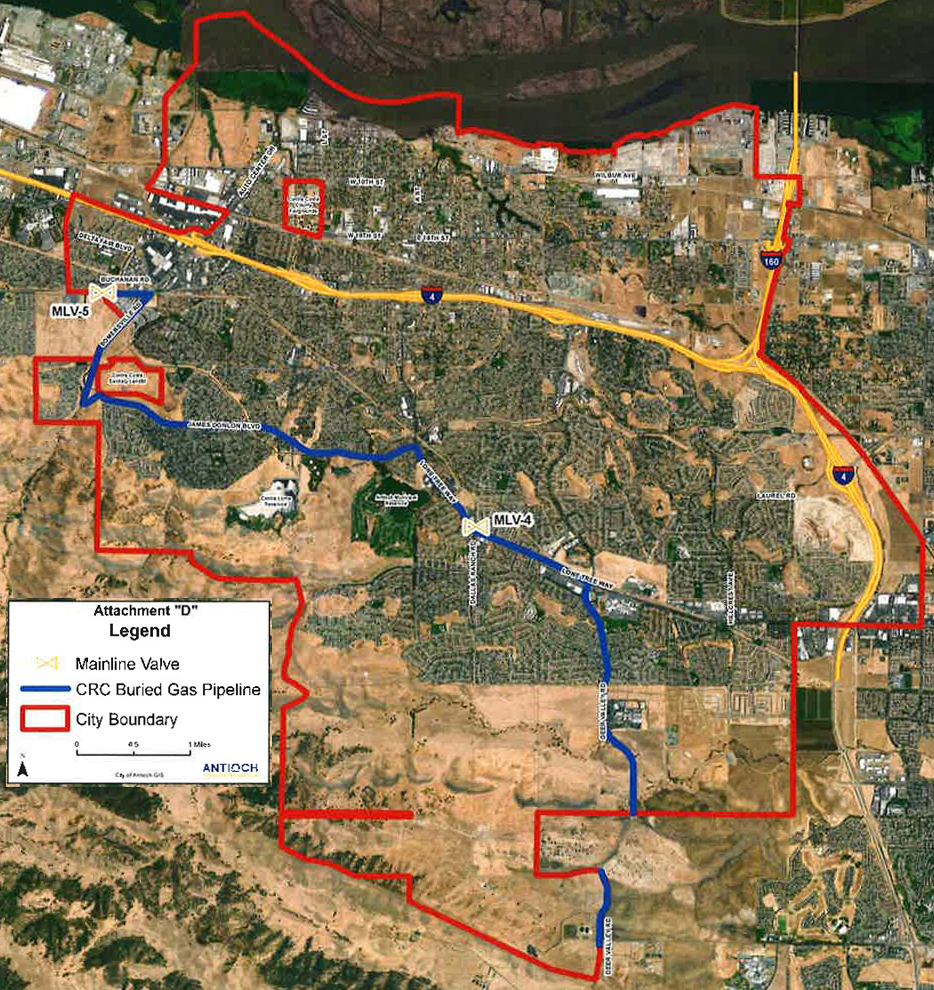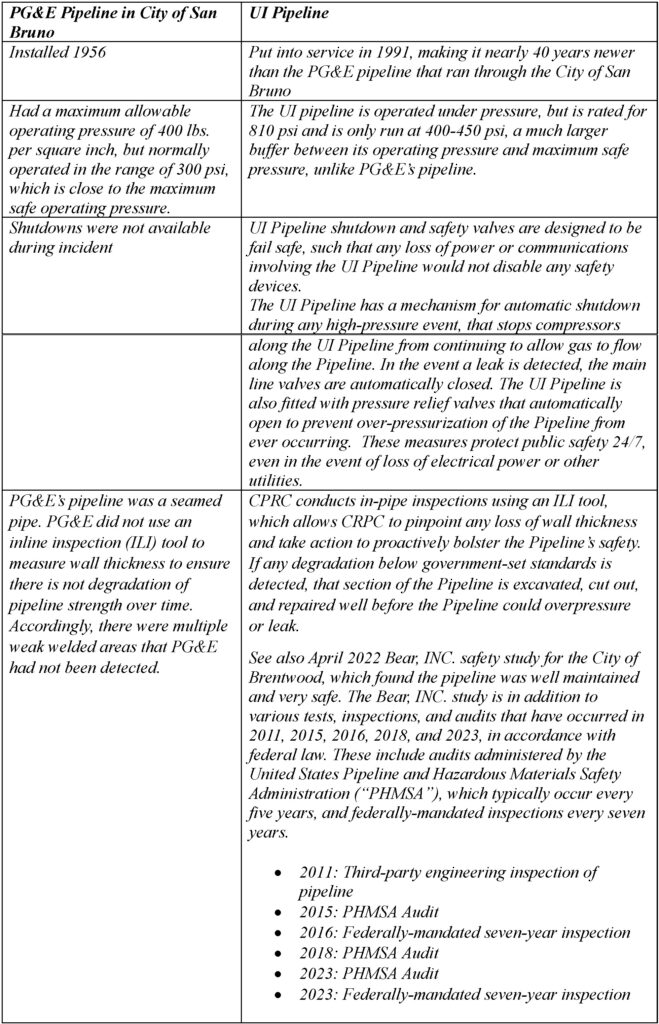Antioch Council majority vote shutting down natural gas pipeline increased greenhouse gas emissions

50% of gas now supplied to owner’s customers in Contra Costa originates in Canada as much as 3,500 miles away instead of 35, about 80% from fracking
“The farther that natural gas must travel to its destination, the greater the carbon emissions” – California Resources Production Corporation
They’re “just doing it for political reasons. That only benefits them, not us on climate change.” – local oil producer Bob Nunn
By Allen D. Payton
After following the lead of the Brentwood City Council, in September 2021, the Antioch City Council voted 2-3 against renewing the franchise agreement for the low-pressure, natural gas pipeline that runs beneath the two communities. That resulted in it being closed and the City foregoing the annual franchise fee of $16,871.90. Pipeline franchise agrmt extension ACC092821
Proposed by District 4 Councilwoman Monica Wilson, Mayor Lamar Hernandez-Thorpe and District 1 Councilwoman Tamisha Torres-Walker joined her in opposing the 35-mile long, 12-inch pipe which carried 1.8 million cubic feet of natural gas daily which is enough to supply about 9,000 homes. District 2 Councilman Mike Barbanica and District 3 Councilwoman Lori Ogorchock supported the motion to renew the agreement. The result has been an increase in the emission of greenhouse gases and a much dirtier product being used by the refineries, from which Antioch is downwind, thus defeating the purpose the three council members claimed was the reason for their action.

The gas had been supplied from the Brentwood natural gas field, and natural gas fields in western San Joaquin County on Union Island in the Delta, southeast of Discovery Bay, as well as in French Camp and Lathrop. But the council’s decision also forced the pipeline company’s customer that it served, Chevron refinery in Richmond, to obtain their supply elsewhere. At least 99% of that supply originates out of state with over half from natural gas fields in British Columbia, Alberta and Saskatchewan east of the Rocky Mountains in Canada, traveling a distance of as much as 3,500 miles instead of just 35.

In Canada, natural gas production is concentrated in the Western Canadian Sedimentary Basin (WCSB), with the highest production in the provinces of Alberta and British Columbia with more than twice as much from Alberta than from BC.

Pipeline Owner Sues City
Following the decision, the company that owns the pipeline, California Resources Corporation (CRC), believed they had the right to continue operating the pipeline. At that time, spokesman Richard Venn, Senior Director, Communications said, “We believe there are legal protections in place that prevent an arbitrary and immediate shutdown, and we will continue to work with the city and its staff on the best solution.”
However, that was not to be the case, the pipeline was shut down, and on Dec. 27, 2021 the company’s subsidiary, California Resources Production Corporation (CRPC), filed a lawsuit against the City of Antioch over the council’s decision.
CRPC did not file a lawsuit against the City of Brentwood and the company has reapplied for the franchise agreement for the portion of the pipeline that runs beneath that city.
CRPC did not file a lawsuit against the City of Brentwood and the company has reapplied for the franchise agreement for the portion of the pipeline that runs beneath that city.
Questions were sent on May 12, 2024, to a representative for CRC about the status of the lawsuit, details about the pipeline and any impacts the change in supply is having on the environment. Venn responded on May 28, 2024, with the company’s answers:
1. Where is CRC in the process with its lawsuit against the City of Antioch? Was one also filed against the City of Brentwood? When were they filed and how soon does CRC expect them to be finalized?
On May 25, 2023, the trial court sustained the City’s motion to dismiss CRPC’s complaint, effectively ending trial court proceedings against the City. On August 25, 2023, CRPC appealed this decision. The parties are currently briefing the appeal. CRPC’s opening appellate brief was filed on April 22, 2024. The City’s brief is due July 3, 2024. CRPC’s reply will be due on August 16, 2024. A decision is unlikely to occur until late 2024 or even early 2025.
No lawsuit has been filed against Brentwood. The application for renewal of the Brentwood franchise is still pending. Per the Brentwood City Council’s request, CRC hired independent consultants, Bear, Inc., to perform a safety study on the Union Island (“UI”) Pipeline, which was published in April 2022. The study confirmed the UI Pipeline is a very well maintained and safe pipeline.
2. If the company had certain rights granted by the California Public Utilities Commission (PUC) that would prevent the cities from stopping CRC from operating the pipeline and continuing to ship gas through it how has the City of Antioch been winning in court? What have been the decisions in favor of the City?
CRPC does not presently have any rights granted to it by the PUC related to the UI Pipeline. However, CRPC has applied for a certificate for public convenience and necessity (“CPCN”) to have the UI Pipeline converted from a private pipeline to a common carrier pipeline. If the CPCN is granted, CRPC would become a regulated public utility, with the CPUC controlling certain aspects of the UI Pipeline’s operations and the rates that CRPC can charge for use of the Pipeline. The UI Pipeline’s day-to-day operations would not change however, after flow through the UI Pipeline restarts, and CRPC would be subject to the same federal and state regulations for safety and environmental protection.
If the UI Pipeline right-of-way were condemned to allow it to resume operations as a common carrier pipeline, as part of the condemnation proceedings, CRPC would have to provide “just compensation” for use of the right of way.
3. Where does the natural gas originate that was running through the pipeline in Antioch and Brentwood?
The natural gas that was running through the pipeline originates from the French Camp, Lathrop, and Union Island natural gas fields in western San Joaquin County and the Brentwood natural gas field in Contra Costa County.
4. Who are the customers served by the pipeline?
The gas is transported from the UI Pipeline to Chevron Corporation’s Richmond Refinery. The gas is used to power the refinery and used in its industrial processes to make jet fuel, diesel and gasoline that is distributed throughout Northern California.
5. From where are those customers now receiving the gas?
The gas that the Richmond refinery is no longer receiving from the UI Pipeline is supplanted by gas from PG&E’s system. The overwhelming majority of PG&E-supplied gas is from out of state. According to the most recent published information on PG&E’s gas sources, over 50% of the natural gas supplied by PG&E comes from Canada via the Gas Transmission Northwest (“GTN”) system. See 2023 California Gas Report, Table 5, https://www.socalgas.com/sites/default/files/Joint_Biennial_California_Gas_Report_2023_Supplement.pdf. Only around 1% of PG&E’s gas comes from California.
Around 80% of the natural gas produced in British Columbia, the upstream production region feeding the GTN pipeline, is produced by fracking. See https://stand.earth/.
6. Is the gas coming from Canada, is it not as clean as that produced in California, and how many miles is the gas now being shipped versus how many miles, previously?
As stated above, 80% of the natural gas produced in British Columbia is produced by fracking. Accordingly, we expect the majority of PG&E gas from Canada to be the result of fracking. This means that by stopping the UI Pipeline from operation, the City may be prioritizing the use of fracked gas.
The GTN system, which transports PG&E’s Canada gas to California, is a > 1,300-mile pipeline system. A map of it can be found at https://www.tcenergy.com/siteassets/pdfs/natural-gas/gas-transmission-northwest/tc-gas-transmission-northwest-map.pdf. (See center map at top of this article)
The >1,300-mile figure does not reflect the total distance Canadian gas must travel to reach Richmond, California, though. The GTN system only runs from the Canadian border in Montana to northern California. Accordingly, Canadian gas going to the Richmond refinery must be transported from wherever the natural gas fields are located in Canada to the mouth of the GTN system in Montana. It must also be transported from northern California to the Bay area. Accordingly, gas from Canada travels well over 1,300 miles to reach the Richmond refinery.
By contrast, the UI Pipeline assisted in the transportation of local gas from the natural gas fields in western San Joaquin County and the Brentwood natural gas field in Contra Costa County to Richmond, a drastically shorter distance.
7. Have there been any environmental impacts because of the change in the natural gas supply to those customers?
The farther that natural gas must travel to its destination, the greater the carbon emissions attendant to those pipeline operations. Additionally, the gas transported by the UI Pipeline is not fracked, as compared to the majority of PG&E’s gas obtained from Canada.
Finally, any GHG emissions from gas production in California are compensated for under the cap-and-trade program, which is not the case in most of the other jurisdictions supplying PG&E.
8. Has there been a change in the costs to CRC’s customer(s) in both the purchase of the natural gas from one or more different sources and the production of their products to their customers? And ultimately to the consumers?
Without the UI Pipeline, local gas cannot be delivered to the Chevron refinery. The contribution of local gas to the refinery helps keep gas prices competitive, which further keeps prices low and the refinery open. The Richmond refinery has a workforce of over 2,700 company employees and 850 contract workers, according to the Richmond Chamber of Commerce. See https://www.rcoc.com/membership-directory-2/name/chevron-richmondlorenz/.
9. Is the pipeline that runs through Brentwood and Antioch different than the high-pressure line that exploded in San Bruno in 2010? What are the differences between the two pipelines?

10. What could the Antioch and/or Brentwood City Council do to remedy the situation?
The City could extend the franchise to allow for operation of the UI Pipeline. With an extension, the City could propose additional conditions on the operation of the Pipeline to address any of its continuing concerns. Using this authority to ensure enhanced protections or benefits for the City, while allowing the Pipeline to safely transport gas as it has for the past thirty years, was not something the City officials considered during the public hearing on the franchise renewal. This kind of win-win solution would have protected the citizens from the costs of litigation, brought revenue to the City, and given the City peace of mind about the UI Pipeline’s operations.
It is also important to keep in mind that the UI Pipeline is by no means the only natural gas pipeline running through Antioch. All federally regulated natural gas and hazardous liquid pipelines can be identified using the National Pipeline Mapping System Public Viewer, which can be accessed at https://pvnpms.phmsa.dot.gov/PublicViewer/.
There are several natural gas transmission pipelines running through Antioch besides the UI Pipeline. Some of these are high-pressure pipelines, in contrast to the UI Pipeline, which is considered a low-pressure pipeline. In addition to these other natural gas pipelines, there are over 34,000 natural gas connections in Antioch.
11. If the council(s) choose to settle the lawsuit(s) would the city(ies) have to reimburse CRC for their attorney’s fees?
The terms of any settlement would govern whether attorney’s fees are reimbursed by either side.
12. Is there anything else you would like to share about the matter?
CRPC is committed to operating in a manner focused on safety, environmental stewardship, and promoting the health and welfare of all Californians. One of our leading “Values” is being a responsible operator, meeting – if not exceeding – California’s high standards for safety and environmental protection. We have a decades-long successful track record of safely and efficiently operating critical energy infrastructure such as the UI Pipeline within the City of Antioch and we look forward to continuing to work with the City and its staff to provide safe, reliable, and low carbon.
Local Environmental and Economic Benefits of Pipeline, Supports Farmers
In addition, CRPC shared information from their application to the state’s PUC about the pipeline and its benefits to the environment and local economy. The company wrote, “The UI Pipeline currently provides the only viable avenue for the natural gas produced from the Fields to reach the market, including the Richmond Refinery, which currently utilizes all of the natural gas carried on the UI Pipeline. The use of in-state natural gas displaces the use of out-of-state natural gas produced in other states and transported by pipeline into California. Currently, California imports over 90% of its natural gas from out-of-state fields where the environmental and greenhouse gas regulations may not be as stringent as those required here in California. Absent the UI Pipeline, production from the Fields would cease and the State would have to look to alternate natural gas capacity at a time when natural gas supply constraints have been widely reported.
“Given California’s current natural gas demand, the natural gas production from these Fields would likely be replaced by out-of-state production, which would be contrary to statutory preferences for in-state production of natural gas and would result in appreciable environmental impacts and increased costs. Natural gas produced out of state is not obligated to follow California’s more stringent environmental and greenhouse gas regulations, and transporting natural gas from out of state through interstate pipelines increases greenhouse gas emissions, as compared to in-state production. Furthermore, in the future, the Field would be capable of converting to carbon dioxide storage and sequestration, which is widely considered a necessary component to achieving long-term climate goals. The UI Pipeline is therefore a key component in not only ensuring the Fields continue to provide in-state natural gas, but also in reducing the environmental impact of natural gas consumption. In-state natural gas production may also mitigate the substantial increases in natural gas costs to California customers over the past year.
“Closure of the UI Pipeline would also have a significant economic impact to the local community. Over 200 local landowners receive revenue from royalties associated with natural gas transported on the UI Pipeline. Many of the royalty holders are local farmers, and monetizing these mineral rights helps support local farming operations. Closure of the UI Pipeline would eliminate any opportunity for those mineral owners to monetize their assets.”
Questions for Council Members Go Unanswered
All five council members were informed of the answers provided by CRPC on Monday, June 24, 2024. Herandez-Thorpe, Wilson and Torres-Walker were asked if, knowing now that the action by the council majority has had a greater impact on the environment, will they reconsider and reverse their vote to deny the franchise agreement allowing the pipeline to resume operations in Antioch.
They were all also asked if they know how much the City has spent to date defending against the lawsuit by the pipeline owner.
None of the council members responded prior to publication time.
Additional Questions for CRC
Asked if the Antioch City Council reverses its decision and approves their franchise agreement can the pipeline reopen, company spokesman Venn said, “The renewal for the franchise for Brentwood is still pending.”
Both cities must approve their separate franchise agreements in order for the pipeline to reopen.
Local Oil Producer Says Council Members “Doing the Opposite of What They Claim”
When reached for comment about the information from CRPC and the council’s decision to shutter the pipeline, Brentwood businessman, Bob Nunn, whose company is the only holder of a permit to drill for natural gas and oil in Antioch said, “We have the strictest rules for oil and gas in California. The energy used to move the gas 100 times further is going to be greater.”
“California is doing its best in the name of climate change. But in the last three years, California has used more oil each year than in the previous year,” he continued. “The production of oil in California to support that demand has gone down each of those three years. CARB (California Air Resources Board) will show you, on the whole, imported oil will have more emissions than oil produced in California.”
“If they’re doing it in the name of climate change, they’re doing the opposite of what they claim,” Nunn stated. “The issue is to lower demand not squeeze supply. It’s Economics 101. Their model is flawed.”
“I support decisions that will reduce man’s impact on climate change. But make sure you do your homework that their positions are for the benefit of climate change,” he said. “If not, then you’re just doing it for political reasons. That only benefits them, not us on climate change.”
Please check back later for any updates to this report.
the attachments to this post:

Gas pipelines in CoCoCounty & 3 cities

Natural gas & oil fields in Canada & pipelines western CAN

























